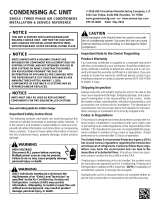
I Split System Condensers R410-A Installation Instructions I
Locating The Outdoor Unit:
Check local codes covering zoning, noise, platforms.
If practical, avoid locating next to fresh air intakes, vent or
bedroom windows. Noise may carry into the openings and
disturb people inside.
Placement of the unit should be in a well drained area or
unit must be supported high enough so runoffwill not enter
the unit.
Do not locate where heat, lint or exhaust fumes will be dis-
charged on unit (as from dryer vents).
Clearances:
Rooftop installations are acceptable providing the roof will
support the unit and provisions are made for water drain-
age and the noise or vibration through the structure.
NOTE: Roof mounted units exposed to winds above 5
mph may require wind baffles. Consult the factory for
additional information.
Do not install the unit in a recessed or confined area where
recirculation of discharge air may occur.
Nominal operating clearances, where practical, are 48
inches (120 cm) above unit for discharge air and 18 inches
(40cm) around coil for intake air on three sides. Clearance
on one side (normally between unit and structure) may be
reduced to 6 inches (15cm). Nominal clearances are based
from a solid parallel object, wall, roof overhang, etc.
Do Not install under roof overhangs without guttering. A
minimum vertical clearance of 48" is required to overhang.
The clearance may be reduced from a single object with a
small surface area, such as the end of a wall, outside cor-
ner of a wall, fence section or a post, etc. As a general rule
the width ofthe object should equal the minimum clearance
from the unit. For example, a 4 inch (10cm) fence post
could be 4 inches (10cm) from the unit.
Unit Support:
Inside corner locations on single story structures require
evaluation. Large overhanging soffits may cause air recir-
culation in a corner area even though recommended clear-
ances are maintained. As aguide locate the unit far enough
out so that half of the discharge grille is out from under the
soffit.
Two or more units may be spaced with 18 inches (45cm)
between units.
A service clearance of 24 inches (60cm) is desirable from
control box end or side. Control box and corner panel be-
low it can be loosened and moved out to the side to facili-
tate servicing. Internal components can be accessed
through control box corner or top only.
The unit must be level, and supported above grade by
beams, platform ora pad. Platform or pad can beof open or
solid construction but should be of permanent materials
such as concrete, bricks, blocks, steel or pressure treated
timbers approved for ground contact. Refer to Unit Clear-
ances to help determine size of supports etc. Soil condi-
tions should be considered so the platform or pad does not
shift or settle excessively and leave the unit only partially
supported.
NOTE: Unit must be level to within 2 deg. (+or- 3/8 in./
ft) per compressor manufacturer specifications.
CAUTION
Inadequate support could cause excessive vibration
and noise or binding and stress on refrigerant lines re-
suiting in equipment failure.
To minimize vibration or noise transmission, it is recom-
mended that supports not be in contact with the building
structure. However, slabs on grade constructions with an
extended pad are normally acceptable.
A. Ground Level Installation:
If beams or an open platform are used for support it is rec-
ommended that the soil be treated or area be graveled to
retard the growth of grasses and weeds.
B. Roof Top Installation:
This type of installation is not recommended on wood
frame structures where low noise levels are required.
Supporting structure or platform for the unit must be level. If
installation is on a flat roof the unit should be 4 inches
(10cm.) above roof level. Four by four posts placed over a
load bearing wall make a suitable mounting platform.
If possible, place the unit over one or more load bearing
walls. If there are several units, mount them on platforms
that are self-supporting and span load bearing walls.
These suggestions are to minimize noise and vibration
transmission through the structure. If the structure is a
home or apartment, avoid (if practical) locating the unit
over bedrooms or study.
NOTE: When condensing unit is to be installed on a
bonded guaranteed roof, a release must be obtained from
the building owner to free the installer from all liabilities.
3LjJ

















